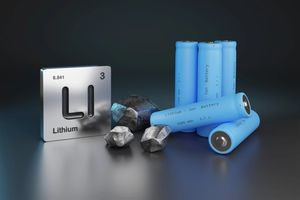- Data Demonstrates 99.9999% PFAS Elimination Through High-Temperature Thermal Destruction at RCRA-Permitted Incinerator
- Study Involved 49 Targeted PFAS Analytes from Eight Primary Chemical Groups
- Study Data and Conclusions Validated by Renowned Environmental Scientist
Clean Harbors, Inc. (“Clean Harbors”) (NYSE: CLH), the leading provider of environmental and industrial services throughout North America, today announced the successful results of a comprehensive third-party study demonstrating that the Company’s commercial facilities can safely and thoroughly destroy PFAS (per- and poly-fluorinated alkyl substances) in multiple forms. Conducted at the Company’s RCRA (Resource Conservation and Recovery Act)-permitted facility in Utah, the study demonstrated that Clean Harbors’ use of high-temperature combustion destroyed greater than 99.9999% of PFAS compounds. This performance level meets the strict chemical destruction standards for many of the most dangerous and difficult to destroy hazardous wastes, such as PCBs and dioxins.
“PFAS compounds, frequently referred to as forever chemicals, represent a clear threat to the environment and human health. Prior to this study, there had been no proven, scalable methodology to permanently destroy these chemicals safely and effectively,” said Eric Gerstenberg, Chief Operating Officer. “We engaged several outside engineering and environmental firms to design a program for us to conduct thorough testing of stack emissions and all residue streams at one of our RCRA-permitted commercial incinerators. We then provided the comprehensive test results to Philip H. Taylor, Ph.D., a nationally recognized environmental scientist who validated the conclusion that high-temperature destruction and removal efficiency of PFAS was achieved.”
Dr. Taylor, who previously led the University of Dayton Research Institute’s Environmental Engineering Group, has more than 30 years of experience dealing with the thermal destruction of hazardous materials. With a total of more than 250 publications and conference proceedings to his credit, Dr. Taylor also has served as an environmental consultant for the U.S. Environmental Protection Agency (EPA), U.S. Department of Energy, the National Science Foundation, and the U.S. Air Force. Dr. Taylor conducted fundamental and applied research on hazardous waste destruction and was awarded the EPA STAR designation for development of the hazardous organic waste incinerability ranking.
PFAS compounds have been manufactured since the 1930s and became a primary ingredient in nonstick and waterproof coatings. After several decades, development and usage of PFAS greatly expanded with wide-ranging applications including nonstick cookware, stain-resistant carpeting, grease-resistant food packaging, corrosive-resistant pipes and wires, and eventually aqueous film-forming foam (AFFF) that became the gold standard for fighting chemical fires for over 50 years. Before scientists and health organizations recognized the potential for adverse impacts on humans and animals, PFAS became ubiquitous around the planet. In fact, today in the United States it is estimated that 97-99% of the population carries some level of PFAS in their bloodstream.
Eventually, the detrimental health effects of certain categories of PFAS became clear and addressing PFAS contaminants in various media has become a major focus of regulatory authorities across the country. While the U.S. Environmental Protection Agency (EPA) has not yet officially labeled PFAS in its many forms as hazardous, the Agency did work with major manufacturers between 2000-2006 to obtain commitments to phase out the production of two forms of PFAS – PFOA (perfluorooctanoic acid) and PFOS (perfluorooctyl sulfonate) – due to health concerns. As of 2015, the manufacture of PFOA and PFOS in the U.S. had largely ceased. In addition, several U.S. states have already begun regulating PFAS in different media, including drinking water, soil, groundwater, and in air emissions.
“One of the challenges with PFAS is that it involves compounds that, in some cases, have been used for more than 50 years,” said Gerstenberg. “Many of these chemicals continue to spread through the environment because they never degrade. There are huge stockpiles of these compounds, as well as contaminated soil and water at countless locations. These include current and former industrial facilities that produced or utilized PFAS; locations still holding AFFF firefighter foam; military bases, airports, or other industrial facilities that frequently used AFFF for years; or in drinking water where it has leached into groundwater from the soil. To date, there has been no consensus on the best method of addressing PFAS. Due to its harmful effects, including strong linkage to cancer rates and other medical conditions, there has been much emotion and even misinformation about PFAS and whether it can be safely destroyed at scale. At Clean Harbors, we have always believed that our RCRA-permitted thermal destruction units, which include state-of-the-art pollution and emission controls, would be the right answer and that data generated by this study would support our confidence in our technology.”
EA Engineering, Science, and Technology, Inc., PBC was retained by Clean Harbors to develop a PFAS destruction testing program, to conduct that testing and to report the results, under the technical oversight of Focus Environmental, Inc. The testing was conducted during the summer of 2021, and the test data and final report were then evaluated and confirmed by Dr. Taylor. The tests included sampling and analysis for 49 target PFAS analytes in incinerator process waste feed streams, treatment chemical feed streams, solid and liquid process residue streams, and incinerator stack gases. The tests included the introduction of waste containing AFFF concentrate.
The results of the 2021 testing demonstrated that common legacy and replacement PFAS – including PFOA, PFOS, PFHxS and Gen-X PFAS – are efficiently and effectively destroyed in Clean Harbors’ high-temperature thermal destruction units at levels exceeding 99.9999% of destruction. Achieving destruction of greater than 99.9999% is equivalent to demonstrating that for every million mass units of a compound introduced into the incinerator, less than one mass unit is detected at the stack. Under the testing conditions, not only were the PFAS compounds sufficiently destroyed, but ambient concentrations from stack emissions were orders of magnitude safer than any state or federal ambient air limit guideline in effect.
“We have been sharing the full results of our third-party study and the assessment of Dr. Taylor with the key regulatory authorities, many of whom are seeking dependable answers on how to best address PFAS going forward,” Gerstenberg concluded. “We believe that when these results are fully reviewed by the scientific community and regulators, they will draw the same conclusion as this third-party study: High-temperature thermal treatment is an ideal option for the safe elimination of the most dangerous members of the PFAS family.”
About Clean Harbors
Clean Harbors (NYSE: CLH) is North America’s leading provider of environmental and industrial services. The Company serves a diverse customer base, including a majority of Fortune 500 companies. Its customer base spans a number of industries, including chemical, energy and manufacturing, as well as numerous government agencies. These customers rely on Clean Harbors to deliver a broad range of services such as end-to-end hazardous waste management, emergency spill response, industrial cleaning and maintenance, and recycling services. Through its Safety-Kleen subsidiary, Clean Harbors also is North America’s largest re-refiner and recycler of used oil and a leading provider of parts washers and environmental services to commercial, industrial and automotive customers. Founded in 1980 and based in Massachusetts, Clean Harbors operates in the United States, Canada, Mexico, Puerto Rico and India. For more information, visit www.cleanharbors.com.
Safe Harbor Statement
Any statements contained herein that are not historical facts are forward-looking statements within the meaning of the Private Securities Litigation Reform Act of 1995. These forward-looking statements are generally identifiable by use of the words “believes,” “expects,” “intends,” “anticipates,” “plans to,” “seeks,” “should,” “estimates,” “projects,” “may,” “likely,” or similar expressions. Such statements may include, but are not limited to, statements about the Company’s potential capabilities to destroy PFAS compounds in its facilities, and other statements that are not historical facts. Such statements are based upon the beliefs and expectations of Clean Harbors’ management as of this date only and are subject to certain risks and uncertainties that could cause actual results to differ materially, including, without limitation, those items identified as “Risk Factors” in Clean Harbors’ most recently filed Form 10-K and Form 10-Q. Forward-looking statements are neither historical facts nor assurances of future performance. Therefore, readers are cautioned not to place undue reliance on these forward-looking statements. Clean Harbors undertakes no obligation to revise or publicly release the results of any revision to these forward-looking statements other than through its filings with the Securities and Exchange Commission, which may be viewed in the “Investors” section of Clean Harbors’ website at www.cleanharbors.com.
View source version on businesswire.com: https://www.businesswire.com/news/home/20221128005047/en/
Contacts
Michael L. Battles
EVP and Chief Financial Officer
Clean Harbors, Inc.
781.792.5100
InvestorRelations@cleanharbors.com
Jim Buckley
SVP Investor Relations
Clean Harbors, Inc.
781.792.5100
Buckley.James@cleanharbors.com





